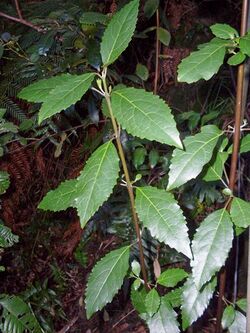Biology:Hedycarya angustifolia
| Hedycarya angustifolia | |
|---|---|

| |
| Native Mulberry growing in a moist gully in the Blue Mountains National Park, Australia | |
| Scientific classification | |
| Kingdom: | Plantae |
| Clade: | Tracheophytes |
| Clade: | Angiosperms |
| Clade: | Magnoliids |
| Order: | Laurales |
| Family: | Monimiaceae |
| Genus: | Hedycarya |
| Species: | H. angustifolia
|
| Binomial name | |
| Hedycarya angustifolia A.Cunn.
| |
Hedycarya angustifolia, also known as the native mulberry or Australian mulberry, is a rainforest plant of south and eastern Australia . Its habitat is cool gullies and moist temperate forests, often at high altitude. Occasionally it is seen bordering sclerophyll forests.
The range of natural distribution is from King Island (39° S) in Bass Strait up to the Australia mainland in the state of Victoria, through New South Wales to the Conondale Range (26° S) in the hinterland of the Sunshine Coast of south east Queensland.
Description
A shrub or small tree, though it occasionally can reach a height of 20 metres and a trunk diameter of 40 cm. The trunk is usually crooked with more than one main stem. The bark is thin; grey or fawn in colour, and is fairly smooth with some vertical lines.
Leaves alternate, toothed, ovate to lanceolate with a pointed tip; 8 to 20 cm long. The leaf stalk is 8 to 20 mm long. The midrib is raised below the leaf, but sunken above. The leaf veins are easily noticed.
Greenish flowers form on a raceme like cyme in the months of August to October. The fruit is a fleshy yellow drupe, ripening from December to January.
Uses
Indigenous Australians used the wood for spear tips and to make bow drills.[1]
References
- ↑ "Aboriginal Plant use and Technology". Australian National Botanic Garden. http://www.anbg.gov.au/gardens/education/programs/pdfs/aboriginal_plant_use_and_technology.pdf. Retrieved 11 November 2016.
External links
- Floyd, A. G. (1989). Rainforest Trees of Mainland South-eastern Australia (1st ed.). Port Melbourne: Elsevier Australia - Inkata Imprint, copyright Forestry Commission of New South Wales (published 1989-12-01). p. 220. ISBN 0-909605-57-2. https://books.google.com/books?id=u9EsAQAAMAAJ&q=Rainforest+trees+of+mainland+south-eastern+Australia+inkata+press. Retrieved 2009-06-13. (other publication details, included in citation)
- "Hedycarya angustifolia". PlantNET - NSW Flora Online. http://plantnet.rbgsyd.nsw.gov.au/cgi-bin/NSWfl.pl?page=nswfl&lvl=sp&name=Hedycarya~angustifolia. Retrieved 2009-06-17.
Wikidata ☰ Q11682368 entry
 |

